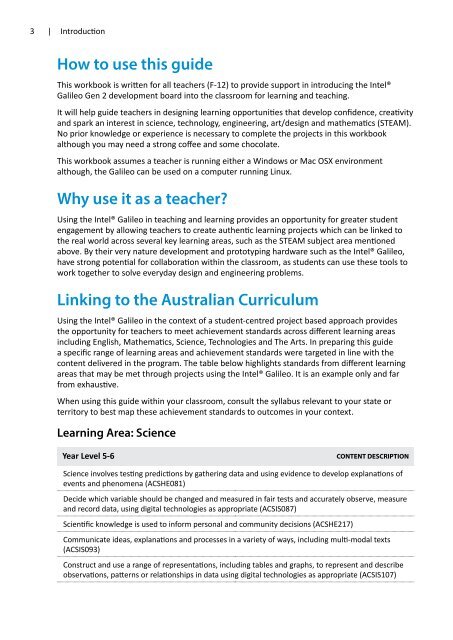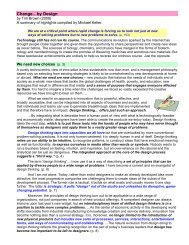A-Teachers-Guide-to-the-Intel-Galileo-Final
A-Teachers-Guide-to-the-Intel-Galileo-Final
A-Teachers-Guide-to-the-Intel-Galileo-Final
You also want an ePaper? Increase the reach of your titles
YUMPU automatically turns print PDFs into web optimized ePapers that Google loves.
3 | IntroductionHow <strong>to</strong> use this guideThis workbook is written for all teachers (F-12) <strong>to</strong> provide support in introducing <strong>the</strong> <strong>Intel</strong>®<strong>Galileo</strong> Gen 2 development board in<strong>to</strong> <strong>the</strong> classroom for learning and teaching.It will help guide teachers in designing learning opportunities that develop confidence, creativityand spark an interest in science, technology, engineering, art/design and ma<strong>the</strong>matics (STEAM).No prior knowledge or experience is necessary <strong>to</strong> complete <strong>the</strong> projects in this workbookalthough you may need a strong coffee and some chocolate.This workbook assumes a teacher is running ei<strong>the</strong>r a Windows or Mac OSX environmentalthough, <strong>the</strong> <strong>Galileo</strong> can be used on a computer running Linux.Why use it as a teacher?Using <strong>the</strong> <strong>Intel</strong>® <strong>Galileo</strong> in teaching and learning provides an opportunity for greater studentengagement by allowing teachers <strong>to</strong> create au<strong>the</strong>ntic learning projects which can be linked <strong>to</strong><strong>the</strong> real world across several key learning areas, such as <strong>the</strong> STEAM subject area mentionedabove. By <strong>the</strong>ir very nature development and pro<strong>to</strong>typing hardware such as <strong>the</strong> <strong>Intel</strong>® <strong>Galileo</strong>,have strong potential for collaboration within <strong>the</strong> classroom, as students can use <strong>the</strong>se <strong>to</strong>ols <strong>to</strong>work <strong>to</strong>ge<strong>the</strong>r <strong>to</strong> solve everyday design and engineering problems.Linking <strong>to</strong> <strong>the</strong> Australian CurriculumUsing <strong>the</strong> <strong>Intel</strong>® <strong>Galileo</strong> in <strong>the</strong> context of a student-centred project based approach provides<strong>the</strong> opportunity for teachers <strong>to</strong> meet achievement standards across different learning areasincluding English, Ma<strong>the</strong>matics, Science, Technologies and The Arts. In preparing this guidea specific range of learning areas and achievement standards were targeted in line with <strong>the</strong>content delivered in <strong>the</strong> program. The table below highlights standards from different learningareas that may be met through projects using <strong>the</strong> <strong>Intel</strong>® <strong>Galileo</strong>. It is an example only and farfrom exhaustive.When using this guide within your classroom, consult <strong>the</strong> syllabus relevant <strong>to</strong> your state orterri<strong>to</strong>ry <strong>to</strong> best map <strong>the</strong>se achievement standards <strong>to</strong> outcomes in your context.Learning Area: ScienceYear Level 5-6CONTENT DESCRIPTIONScience involves testing predictions by ga<strong>the</strong>ring data and using evidence <strong>to</strong> develop explanations ofevents and phenomena (ACSHE081)Decide which variable should be changed and measured in fair tests and accurately observe, measureand record data, using digital technologies as appropriate (ACSIS087)Scientific knowledge is used <strong>to</strong> inform personal and community decisions (ACSHE217)Communicate ideas, explanations and processes in a variety of ways, including multi-modal texts(ACSIS093)Construct and use a range of representations, including tables and graphs, <strong>to</strong> represent and describeobservations, patterns or relationships in data using digital technologies as appropriate (ACSIS107)



